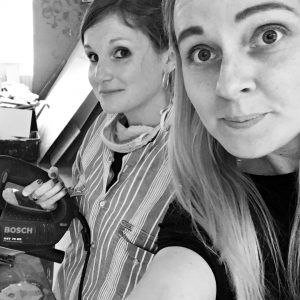"MoFu 365/360" creatives:

Andrea Uváčiková and Zuzana Bartošová
Profile
Contemporary visual artist Zuzana Bartošová mostly deal with sculpture and mixed 3D media. Main topic of her creation is circulation, repetition and cycles. She experiments with new materials and 3D prints, its limitations and creates interactive installations react to the gallery visitors or the immediate area surrounding the work. She works as a head of Design and visual communication department in Secondary School of Applied Arts in Jihlava Helenín.
Contemporary visual artist Andrea Uváčiková studied Graphic design at the Secondary Art School in Trenčín, then the Graphics Art Studio at the Faculty of Arts of the University of Ostrava. In 2015–2019 she studied for a doctorate at the Department of Art Education, Faculty of Education, Masaryk University. Since 2020, she has been working as an assistant professor at the Graphics Studio at the Faculty of Arts of the University of Ostrava. She mainly works with new media, but also with classical graphic techniques and its overlaps to the other media, for example moving image, sound art or performance. In her works, she examines the issue of perception of reality, which she subjects to constant criticism through remediation.
“Our work represent circulation, cycles, research over media and its limitations, interest in objects and imprints, new technologies and its confrontation with the traditional media (scuplture and graphic). In our work there is always action-reaction between each other / action-reaction to the environment and perception. Important part of aour work i salso transformation through various media, fluidity, volatility, ephemerality.”
Objects being interpreted
About the project
The project “Arte-Factum” is based on the morphology of the Hardware store building, which has undergone changes over the years. Our goal is to point out the development of the external features of the building (external features), but also the connection with the purpose for which the building was used (internal context). We want to relate the modernist features that the building bears to the ideas of modernity (in general) through contextualization. We choose architecturally interesting parts of the exterior and interior of the building, from which we plan to create scale 3D models from original materials (concrete, glass, etc.). This will create a series of models that act as museum artifacts, and the architecture of our exhibition is also conceived in this style. The artifacts will be supplemented by QR codes, which take over the function of “labels” for the works, similar to what is the case in museums. After displaying the QR code, however, a caption does not appear, but a link to an animation that works with the visual morphology of a particular artifact. Animation acts at first as games (literally referring to them somewhere – tetris), but over time their original meaning, transformation, or more general context to the ideas of modernism that they mediate begins to appear. As an accompanying event, there will be placed interactive posters, which follow the tectonics of the building. The aim of the project will be to draw the viewer’s attention to interesting architectural elements and to place scaled elements in the city space. During the residence we want to create objects made of special polystyrene, which will represent enlarged parts of the building. These objects will be distributed around the city and will be accompanied by posters with photographic representation of objects. Posters will include a link to animations related to the objects.
Photos from the personal archives of the artists.



